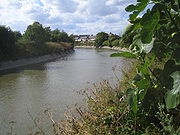
Prescott Channel
Encyclopedia


River Lee Navigation
The Lee Navigation is a canalised river incorporating the River Lea . Its course runs from Hertford Castle Weir all the way to the River Thames at Bow Creek. The first lock of the navigation is Hertford Lock the last being Bow Locks....
in the East End of London
East End of London
The East End of London, also known simply as the East End, is the area of London, England, United Kingdom, east of the medieval walled City of London and north of the River Thames. Although not defined by universally accepted formal boundaries, the River Lea can be considered another boundary...
, and was named after Sir William Prescott
Sir William Prescott, 1st Baronet
Sir William Henry Prescott, 1st Baronet CBE, DL was a British engineer and Conservative Party politician.The son of John Prescott, he initially studied law and was called to the bar at Gray's Inn in 1909...
, the then chairman of the Lee Conservancy Board. Rubble from the demolished Euston Arch
Euston Arch
The Euston Arch, built in 1837, was the original entrance to Euston station, facing onto Drummond Street, London. The Arch was demolished when the station was rebuilt in the 1960s, but much of the original stone was later located—principally used as fill in the Prescott Channel—and proposals have...
was used in 1962 to improve the channel.
Three Mills Lock
Three Mills Lock
Three Mills Lock, also known as the Prescott Lock is a lock on the Prescott Channel on the River Lea in London. The project was led by British Waterways and the lock officially opened on 5 June 2009....
is a lock
Lock (water transport)
A lock is a device for raising and lowering boats between stretches of water of different levels on river and canal waterways. The distinguishing feature of a lock is a fixed chamber in which the water level can be varied; whereas in a caisson lock, a boat lift, or on a canal inclined plane, it is...
in the channel to allow passage of freight for the London 2012 Olympics by a process of canalisation (with the result of stopping the tidal flow) on the channel and the River Lee northwards. It was constructed between March 2007 and June 2009. The project was credited with offering additional benefits:-
"As well as helping barges carrying construction materials and recyclables between Stratford and the River Thames, the lock will also create new opportunities for leisure boats, water taxis, trip boats and floating restaurants."
A major benefit for British Waterways is the increased value of the land which it holds in areas no longer subject to flooding, which comfortably exceeds the cost of the project.
The new lock is 62 metres long, 8 metres wide and 2.4 metres deep, and can hold two 350 tonne barges (the present locks on the Lower Lee limit barges to about 120 tonnes). It was designed by Tony Gee and Partners and built by Volker Stevin
VolkerWessels
VolkerWessels N.V. is a major European construction-services business with Dutch-based headquarters. It is privately owned by the Wessels Family , CVC Capital Partners and management .-History:...
.
On 2 June 2008, work on the channel brought up a 2200 pound (0.997903214 t) Hermann
SC1000 bomb
The SC 1000 bomb was an air-dropped general-purpose demolition bomb used by Germany in World War II. Over 1,000 lb Amatol. Weighing 1,000 kg, it was nicknamed the Hermann by the British in reference to the portly Luftwaffe commander, Hermann Göring. Many of them were dropped on the...
war time bomb. Residents were evacuated, tube and rail services were disrupted, and flights from London City Airport
London City Airport
London City Airport is a single-runway airport. It principally serves the financial district of London and is located on a former Docklands site, east of the City of London, opposite the London Regatta Centre, in the London Borough of Newham in east London. It was developed by the engineering...
were curtailed during the emergency. The 67-year old, booby-trapped bomb was finally made safe, after five days, in a controlled explosion that threw 400 tonnes of sand into the air. Major Matt Davies, of the Army Bomb disposal unit said “If it had gone off in wartime there would have been large fragments up to a mile away which could have destroyed buildings and sewers". He added "This is the biggest unexploded bomb
Unexploded ordnance
Unexploded ordnance are explosive weapons that did not explode when they were employed and still pose a risk of detonation, potentially many decades after they were used or discarded.While "UXO" is widely and informally used, munitions and explosives of...
we have found in central London."
See also
- Canals of the United KingdomCanals of the United KingdomThe canals of the United Kingdom are a major part of the network of inland waterways in the United Kingdom. They have a colourful history, from use for irrigation and transport, through becoming the focus of the Industrial Revolution, to today's role for recreational boating...
- History of the British canal systemHistory of the British canal systemThe British canal system of water transport played a vital role in the United Kingdom's Industrial Revolution at a time when roads were only just emerging from the medieval mud and long trains of pack horses were the only means of "mass" transit by road of raw materials and finished products The...

